July 10, 2015
Air Date: July 10, 2015
FULL SHOW
SEGMENTS

The Supreme Court Blocks EPA's Mercury Rule --For Now
View the page for this story
The EPA has been trying for years to limit pollutants from power plants. But the proposed rule to cut toxic mercury was challenged by industry and the case argued up to the Supreme Court, which ruled that EPA did not appropriately take account of costs. But as Former EPA Administrator Carol Browner tells host Steve Curwood, while the ruling is disappointing, the EPA can amend the mercury rule to better consider cost and continue to push for strong regulation. Vermont Law Professor Pat Parenteau also explains the legal details. (07:15)
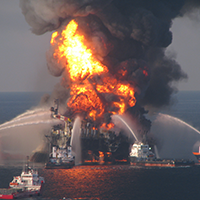
BP Will Pay $18.7 Billion to Settle Gulf Oil Spill Fines and Gov't Claims
View the page for this story
Five years ago, the Deepwater Horizon oil disaster caused billions of dollars in economic and environmental damages for the Gulf region. Civil and criminal lawsuits have kept BP in court for years, but an agreement might soon bring relief for those government agencies seeking fines and compensation. Mark Schleifstein, environment reporter for NOLA.com/Times-Picayune, tells host Steve Curwood about BP’s proposed settlement and why the smaller-than-expected sum is still a win for government plaintiffs. (07:05)

Arsenic and Frackwater Waste
/ Reid FrazierView the page for this story
Frackwater contains many toxic elements and chemicals that contaminate groundwater, if it spills. The Allegheny Front’s Reid Frazier reports that when this wastewater from fracking spills, microbes start to clean it up, but the process can release arsenic, which also pollutes groundwater. (07:35)

Fingerprinting Frackwater
View the page for this story
Determining the source of water contamination in the environment is tricky, as many industrial pollutants are similar to naturally occurring chemicals. A recently developed method of “water forensics” could help determine if a frackwater spill is the culprit. Robert Jackson of Stanford University explains this method to Living on Earth’s Emmett Fitzgerald and describes why it’s important to pinpoint the source of environmental pollutants. (06:10)
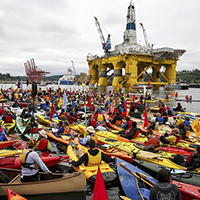
Beyond the Headlines
/ Peter DykstraView the page for this story
In this week’s trip beyond the headlines, Peter Dykstra tells host Steve Curwood about recent developments and controversies surrounding Arctic oil drilling. He also looks back 100 years at some influential events and historical figures that kicked off the energy industries, which fuel the economy and ignite environmental concerns today. (04:15)
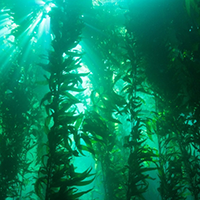
Restoring Giant Kelp Forests
View the page for this story
California’s giant kelp forests were mostly wiped out by ecosystem imbalances, but a decades-long citizen science effort has helped restore them. Host Steve Curwood speaks with marine biologist Nancy Caruso about the fragile ecosystem, the restoration she led, and California’s majestic kelp forests. (11:50)
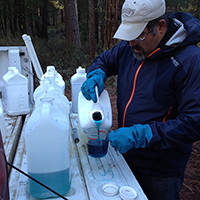
Fighting Invasive Ribbon Grass
/ Courtney FlattView the page for this story
Ribbon Grass growing along Oregon’s Metolius River is attractive, but the invasive plant has edged out acres of native sedges and wildflowers. EarthFix’s Courtney Flatt reports how locals and state groups are pulling out and poisoning the weed to protect the river’s ecosystem. (03:15)
Show Credits and Funders
Show Transcript
HOST: Steve Curwood
GUESTS: Carol Browner, Mark Schleifstein, Robert Jackson, Nancy Caruso
REPORTERS: Peter Dykstra, Reid Frazier, Courtney Flatt
[THEME]
CURWOOD: From Public Radio International, this is Living on Earth.
[THEME]
CURWOOD: I'm Steve Curwood. The Supreme Court has ruled against the EPA’s attempt to control toxic mercury pollution from power plants but the rather technical decision doesn’t totally derail the clean up bid.
BROWNER: The EPA, the White House, the Justice Department -- obviously disappointed; this was a hugely important case from their perspective. It's good news that it's a very narrow decision; it simply says: “EPA - yes, you looked at cost, but you should have looked at it earlier.”
CURWOOD: Still the ruling could have a hidden silver lining for forthcoming EPA rules on climate changing gases from power plants – and the back-breaking task of yanking a pretty but invasive grass from a river by hand.
SCHAY: It’s very heavy. It’s mostly water. It’s 99 percent water that you’re pulling...dragging around.
CURWOOD: Wrestling with ribbon grass and more this week on Living on Earth. Stick around.
[NEWSBREAK MUSIC: Boards Of Canada “Zoetrope” from “In A Beautiful Place Out In The Country” (Warp Records 2000)]
ANNOUNCER: Support for Living on Earth comes from United Technologies – innovating to make the world a better, more sustainable place to live.
[THEME]
The Supreme Court Blocks EPA's Mercury Rule --For Now
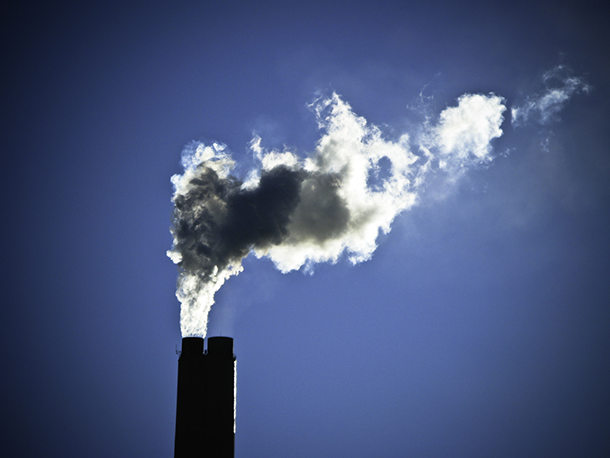
Coal-fired power plants emit more than half of the total US airborne mercury emissions. (Photo: Nick Humphries, Flickr CC BY-NC-ND 2.0)
CURWOOD: From the Jennifer and Ted Stanley Studios in Boston and PRI, this is Living on Earth. I’m Steve Curwood. By the narrowest of margins, 5 to 4, the US Supreme Court recently pushed back against federal rules that would require power plants to clean up their emissions of the toxic metal, mercury. Writing for the majority, Antonin Scalia said the Environmental Protection Agency had failed to consider the cost of the clean up early enough in its rule making process. A lower court will decide if EPA can fix the defects or if the mercury rule must be thrown out entirely. The decision is being closely watched as a precedent for the lawsuits that are expected when rules limiting power plant emissions of global warming gases are issued later this summer. Carol Browner was head of the EPA during the Clinton Administration when mercury rules were first proposed, and she joins us now. Welcome back to Living on Earth.
BROWNER: Thank you. Nice to be here.
CURWOOD: So how might this decision affect EPA's authority to regulate mercury emissions from power plants?
BROWNER: Well, I think it's an unfortunate decision in that EPA has to go back and do it over again. I think that the good news is that states had set mercury standards--industry had started to shut off, retire some of the older facilities. You know, it's a narrow decision, but nevertheless EPA's going to have to go back and sort of redo some of the work.
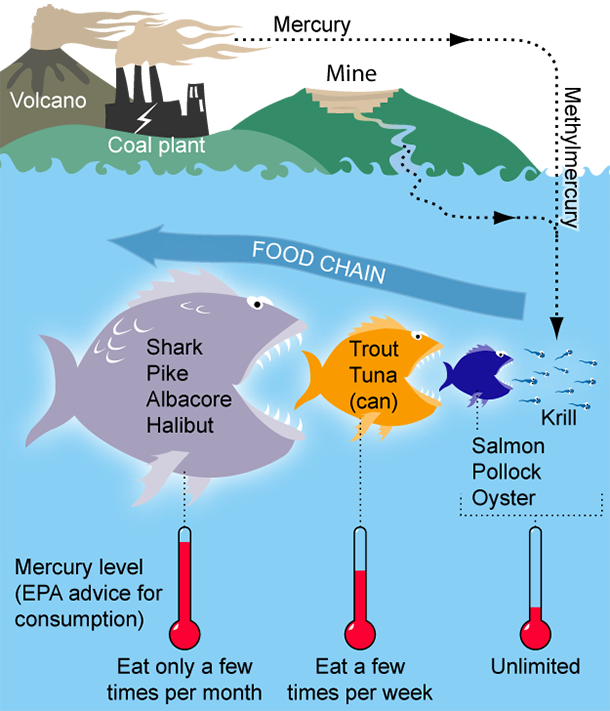
Mercury is an element that bioaccumulates, or builds up in the body faster than the organism can get rid of it. Bioaccumulation of mercury occurs in humans as well as animals and is especially prevalent in certain fish species, including tuna, marlin, and swordfish. (Photo: Bretwood Higman/Ground Truth Trekking, Wikimedia CC BY 3.0)
CURWOOD: So what are the implications of the court's decision that only so-called "direct benefits" can be considered? I mean how might this influence the case for limiting EPA's power plant rules regarding carbon dioxide, for example?
BROWNER: Well, I think EPA's ability to regulate carbon pollution from power plants, it's a different section than the section of the law that the Supreme Court looked at with regards to mercury, but it is true that when you regulate one pollutant you require a scrubber or some technology to be put on a smokestack, you frequently get reduction in other pollutants. That's good news, and in this case there were significant fine particle reductions in addition to the mercury reductions. And the court seems to be suggesting that you can't count those benefits. I think in the case of carbon pollution, the consequences, the cost to our health, to our environment of carbon pollution are so high that any sort of cost-benefit analysis should be fine.
CURWOOD: What's the mood inside the EPA and the White House in response to this ruling do you think?
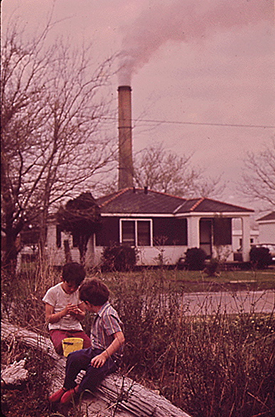
Mercury is especially toxic for children because it impairs neurological development, affecting cognitive thinking, memory, attention, language, and fine motor and visual spatial skills. (Photo: John Messina, CC government work)
BROWNER: Well, I think the EPA, the White House, the justice department obviously disappointed. This was a hugely important case from their perspective. The Solicitor General actually argued the case. It's good news that it's a very narrow decision. It simply says, “EPA, yes you looked at cost but you should've looked at it earlier in the decision-making process”. Under this statute, this section of the Clean Air Act, there’s sort of a two-step process: first you look at the science...mercury...is it dangerous to people, how dangerous is it, and then what EPA did is looked at all the power plants that emit mercury and there are many different types of power plants on a sort of type-by-type basis, set standards based on how much it would cost. And in some instances they said you're not going to have to do anything because it's not cost-effective, so they did look at cost, they looked at it endlessly. What Scalia and the majority are saying is you should have looked at cost in the first decision, in the science decision.
CURWOOD: You know, this decision reminds me of a scene from the Greek myth, the myth of Sisyphus. The guy is trying to roll this rock all the way uphill, he gets just to the top and it rolls back. The US government's been trying to regulate mercury since you were running the EPA back during the Clinton administration. What's going on here?
BROWNER: It's been a long road, the efforts to regulate mercury. We focused on smaller sources - that's the way the law works - you start with the smaller incinerators and work your way up to the largest which are the power plants, and the Bush administration could've easily continued the work I had begun. They chose not to follow the path. They lost in court. And then the Obama administration, Lisa Jackson, came back and said OK, we're going to go back to sort of where Browner was and move forward. It's been a lot of time and I think that's extremely unfortunate, but I think it's also a testament to how complicated and thoughtful these decisions are.
CURWOOD: While you were EPA administrator, you took pretty tough actions to eliminate pollution from smog and particulates. What were the legal challenges to getting those rules passed and how did the EPA go about quantifying cost and benefits back then, especially indirect benefits?

For two years during the Obama Administration, Carol M. Browner served as advisor to the President on Energy and Climate Change Policy. Previously, Browner served as EPA Administrator during both terms of Clinton’s Presidency. (Photo: Obama-Biden Transition Team, Wikimedia CC BY 2.0)
BROWNER: Well, interestingly, Scalia, who wrote the majority opinion on mercury, also wrote a majority opinion reviewing the pollution standards that I set, the soot and smog standards, and in that case it was a 9-0 ruling and he agreed with our argument that we didn't have to take cost into effect in setting these ambient air quality standards because what Congress had told us to do was set a public health standard based on the best available science. Now, it's a different section of the law, but obviously was a very important win for EPA because industry argued, no you should be setting it based on how much it's going to cost us, to reduce our pollution and whether the benefits of cleaner air exceed those costs to industry. And in that case, the court said, no, they’ve done it the right way. In this case they're saying, yes, you looked at costs, but you should've looked at it earlier in the process. And I think the concern we should all have is that if we move towards setting environmental pollution standards, workplace safety, whatever...car safety standards on a cost-benefit analysis we may not get the kind of important science-based standards that have brought us safety and cleaner air and cleaner water because when you look at cost before you actually regulate a pollutant, for example, you're guessing what the technology’s going to be and the costs inevitably are higher and they turn out to be once the standard to set because American innovation and ingenuity find a cheaper solution.
CURWOOD: What are the next steps the EPA will be taking to implement a mercury emissions rule given industry’s propensity to say it's going cost too much?
BROWNER: Well, I think this case is very interesting because when EPA goes back to the rule there will be objective cost numbers available because so many plants are already complying with the mercury requirements. So here they're going to have very realistic numbers. That is not a usual turn of events obviously.
CURWOOD: And by the way what is the status of this rule today if I were running up a power plant? Do I have to limit mercury or not while this legal wrangling continues?

Pat Parenteau is a professor at the Vermont Law School, where he teaches on environmental litigation. (Photo: Vermont Law School)
BROWNER: So some states separately have mercury requirements in place and so those would obviously continue, and a number of plants have shut down in anticipation of these requirements. So the actual consequence of this may be small but my sense is EPA will move quickly to fix the situation.
CURWOOD: Carol Browner was EPA's Administrator during President Clinton's term, and former assistant to President Obama for energy and climate change. She now chairs the League of Conservation Voters. Thanks so much for taking the time with us today.
BROWNER: Thank you.
CURWOOD: And there’s a discussion with Vermont Law Professor Pat Parenteau on the legal issues of the Supreme Court decision and its implications at our website, LOE.org.
Listen to our discussion with environmental law professor Pat Parenteau:
stream/download this segment as an MP3 file
Related links:
- High Court Strikes Down EPA Limits on Mercury Emissions
- MATS Rules Declared Invalid in Michigan v. EPA, 5-4
- The Supreme Court throws a wrench in the EPA’s crackdown on mercury pollution
- Health Effects of Mercury
- Supreme Court Majority Opinion by Justice Scalia
- EPA’s Regulatory Impact Analysis for the Final Mercury and Air Toxics Standards
- Listen to our previous discussion with Pat Parenteau on the mercury rule
BP Will Pay $18.7 Billion to Settle Gulf Oil Spill Fines and Gov't Claims
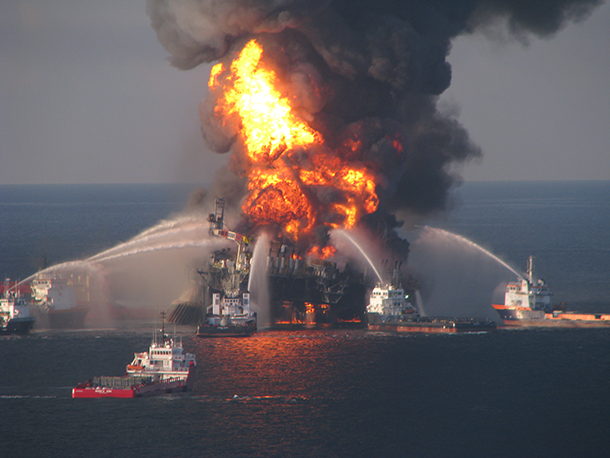
Fireboat response crews battle the blazing remnants of the offshore oilrig Deepwater Horizon. A Coast Guard MH-65C dolphin rescue helicopter and crew document the fire while searching for survivors. Multiple Coast Guard helicopters, planes and cutters responded to rescue the Deepwater Horizon's 126-person crew. (Photo: US Coast Guard/Public Domain)
CURWOOD: Legal issues are also central to the settlement recently announced between BP and the federal government, the states of Louisiana, Texas, Mississippi, Alabama and Florida and some localities over the catastrophic oil well blowout in the Gulf of Mexico in 2010. In exchange for $18.7 billion dollars, portions of which will not be delivered for as many as 18 years, the government agencies agreed to halt their litigation efforts against the giant oil company. So these plaintiffs get cash sooner, and BP won’t pay as much as they could be liable for under the Clean Water Act. Private suits will still continue, and the trial judge has already declared BP “grossly negligent” in the disaster that left much of the Gulf of Mexico polluted with crude oil and oil dispersants. Mark Schleifstein is a reporter with NOLA.com/the Times Picayune, and joins us now. Welcome to Living on Earth.
SCHLEIFSTEIN: Well, thank you. Appreciate it.
CURWOOD: What is the breakdown of this $18.7 billion? Who will receive, how much, and when?
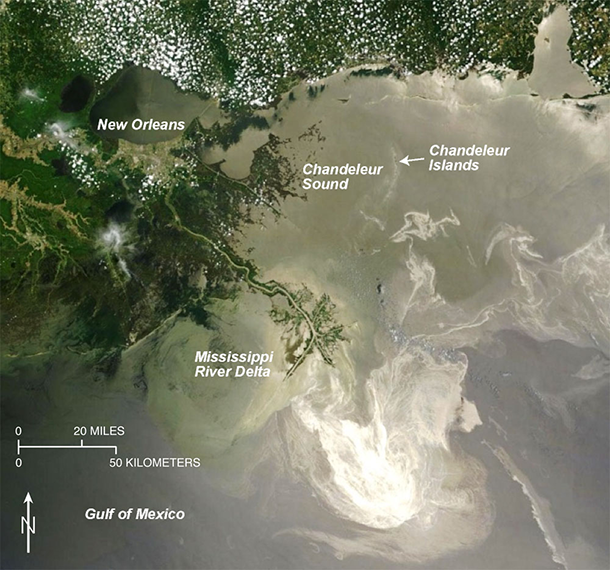
MODIS (Moderate Resolution Imaging Spectroradiometer) satellite imagery from May 24, 2010, showing the Deepwater Horizon oil spill (light color) approaching the Chandeleur Islands and Louisiana coast. (Photo: USGS)
SCHLEIFSTEIN: Well, you've got several pots of money that are involved here. BP’s going to be a paying $5.5 billion in Clean Water Act civil penalties over a 15-year period. And 80 percent of that will go into the Restore Act Trust Fund. Now the Restore Act requires that 80 percent to be used on restoration projects aimed at restoring the damage done by the oil spill along the Gulf Coast in the Deepwater Gulf of Mexico, so a big chunk of that money will go to individual states and also to federal agencies for specific projects.
The second pot is also aimed at restoration and that's about $7.1 billion that will go to the US and the five gulf states over 15 years for natural resource damages under the Oil Pollution Act, and BP had already put up $1 billion so that's an additional $7.1 billion, that billion dollars already is being spent on a variety of different projects in the five states, and a portion of that money can also be used to compensate for lost opportunities, for fishing and boating and other things, so a portion of that money might be able to be used for projects that are more aimed at recreation.
CURWOOD: So let's see, we have so far over $5 billion allocated, over $7 billion allocated, another billion... but still we're not quite to the $19 or so billion. What else?
SCHLEIFSTEIN: Right. There's another $4.9 billion that will be distributed over 18 years to settle economic and other claims by the five Gulf coast states, and then another billion dollars to resolve claims by more than 400 local governmental entities and that includes in Louisiana parishes and other states, counties, but also cities and school boards, things like that, largely for lost tax revenue that occurred during the time of the spill.
CURWOOD: The judge had found BPA guilty of gross negligence and some had calculated the fines would be much higher, at least on the Clean Water side of this. Why were the plaintiffs willing to settle for this overall almost $19 million package?
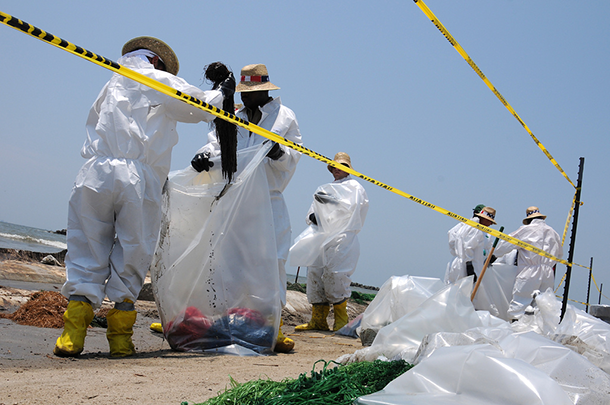
In Louisiana, a Health Safety and Environment (HSE) worker collects pieces of an oiled snare boom so it can be disposed of safely on May 29, 2010. Hundreds of HSE workers contracted by BP—and under the direction of the U.S. Coast Guard—are cleaning up oil from the Deepwater Horizon/BP oil spill, which began washing up on beaches here one month after the drilling rig exploded and sank. (Photo: US Coast Guard, Petty Officer 3rd Class Patrick Kelley, Flickr CC BY-ND 2.0)
SCHLEIFSTEIN: It largely has to do with the fact that this was going to be a rather lengthy court proceeding. Even after the judge ruled it was likely based on what BP was already doing in the private claims settlement that the company was going to appeal any sort of decision and that could've delayed payments for years if not even a decade.
CURWOOD: Like the Exxon Valdez case, for example, I think there’s money still to be paid under that case.
SCHLEIFSTEIN: Well, that's true. Now the Exxon Valdez part of the problem was that some of the damage wasn't recognized until after the initial settlement was made, and there's actually a provision in this for about $230 million to be saved until the end of the first 15 years for potential natural resource damages that might occur after that.

Cleaning an oiled Gannet after the Deepwater Horizon oil spill. (Les Stone, International Bird Rescue Research Center, wikimedia CC 2.0)
CURWOOD: What about the natural resource damage assessment? I know that a number of scientists, and states and of course, BP itself as well, conducted studies regarding the extent of the damage? How does the number that the researchers found play into this $18.7 billion dollar settlement?
SCHLEIFSTEIN: One of the problems here is that we don't have the formal settlement agreement to see exactly how that part of the agreement plays out. What we know is it a number of peer-reviewed scientific reports that have been published in scientific journals over the last five years, and the estimates for that have been all over the place. Some estimates were as much as another $30 billion and under this process it's my understanding that that report will eventually be written, but it will now be written within the confines of the financial dollars that are included in the settlement.
CURWOOD: So do a little math for me please, Mark, how much money has BP paid already for cleaning up this spill and the fines and with this proposed settlement, what will this all total to?
SCHLEIFSTEIN: I think the last time that they put out an estimate they said they had already set aside about $42 billion to pay for things including the initial response and recovery efforts that were already underway, so this is another $18 billion on top of that. Total amount, we're looking at getting close to $60 billion.
CURWOOD: This settlement has to be approved by the judge and I gather he'll have some hearings before he approves or rejects it. What's the sense, what the judge will do with this agreement at this point?
SCHLEIFSTEIN: I think he's going to listen, but I think he's also very interested in getting this portion of the legal battle over, so I think he's expected to pretty much put his imprimatur on it.
CURWOOD: What are some of the strongest complaints about this proposed settlement?

Mark Schleifstein is a hurricane and environment reporter with NOLA.com/The Times-Picayune (Photo: Mark Schleifstein)
SCHLEIFSTEIN: Well, the biggest one obviously is that it's not enough money. We've already seen Oceana, which concludes that its constituency is the Deepwater Gulf of Mexico, the wildlife and fisheries. They contend that the natural resource damage assessment dollars should've been closer to $30 billion and that the Clean Water Act fine should've been at the maximum amount at least if not more. So that's a significant difference between what the settlement is. And again, of course, the parties to the settlement contend that this speeds the process up and removes delays that could be years.
CURWOOD: Mark Schleifstein is a Pulitzer prize-winning reporter with Nola.com/the Times Picayune. Thanks so much for taking the time with us today, Mark.
SCHLEIFSTEIN: Well, thank you I appreciate it.
Related links:
- “BP Deal Will Lead to a Cleaner Gulf”
- “BP Agrees to Pay $18.7 Billion to Settle Deepwater Horizon Oil Spill Claims”
- “With Options Dwindling, BP Seized a Chance to Settle Oil Spill Case”
- “Deepwater Horizon Oil Spill: An Interactive Look at What Happened”
- Regional stories on BP oil spill, lawsuit, settlement and money use
- Unrelated spill claims made against BP after the spill
- About Mark Schleifstein
[MUSIC: Johnny Greenwood, Prospectors Theme, There Will Be Blood Soundtrack, 2007]
CURWOOD: Coming up...oil companies are getting cold feet about drilling in the Arctic Ocean—with a notable exception. Stay tuned to Living on Earth.
[CUTAWAY MUSIC: Rick Braun, Coolsville, Body and Soul, Mesa/Blue Moon Recordings Inc. 2010]
Arsenic and Frackwater Waste
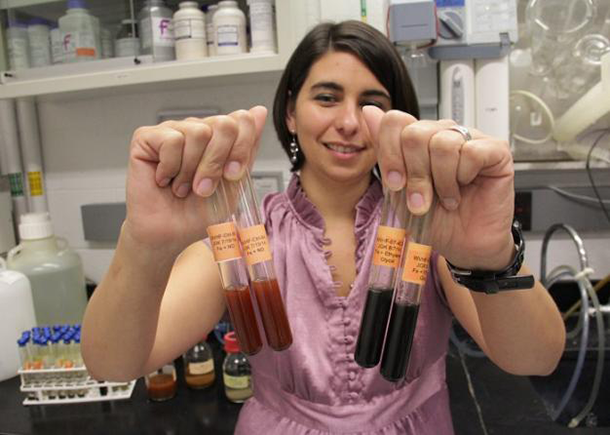
U.S. Geological Survey researcher Denise Akob holds vials filled with iron minerals. The vial on the right contains sediment from a stream contaminated with oil and gas waste, and has turned black because of bacterial reactions with the sediment. (Photo: Reid R. Frazier)
CURWOOD: It's Living on Earth. I'm Steve Curwood. Earlier this year, the US Geological Service detailed what exactly it found in wastewater left over from fracking natural gas and oil.
Treating and disposing of the huge amounts of noxious wastewater that result from frack wells depends on a proper analysis of the water, and a few months ago, Reid Frazier of the public radio program the Allegheny Front checked in on the scientists hard at work to figure this out.
FRAZIER: Denise Akob is a microbiologist for the US Geological Survey. In a USGS lab outside of Washington, DC, she holds up a glass jar filled with water. At the bottom of the jar is what looks like sand.
AKOB: It’s got this brown color. It’s rocky. The water still really clear.
FRAZIER: The sediment is from a clean streambed. It’s been inside the bottle for 90 days. Akob holds up a second bottle. This one’s not so clear. Inside of it is sand from a stream in West Virginia that was polluted by a leaking oil and gas wastewater impoundment.
AKOB: You actually can’t even see through the bottle.
FRAZIER: An orange goo coats the sides of the second bottle. The goo is iron oxide--rust. It’s the result of a chemical reaction between microbes in the sediment and contamination in the streambed. The experiment is part of a research project at the USGS to determine the risk posed by fracking wastewater. The oil and gas industry produces billions of gallons of this waste every year. It’s the briny liquid that comes out of a well after it’s been hydraulically fractured with millions of gallons of water. The waste is tainted with chemicals from fracking fluid, and has toxic levels of metals and salts from underground formations.
COZZARELLI: One of the main things we’re trying to do on this project is identify what the important potential pathways to the environment are.
FRAZIER: Isabelle Cozzarelli is a geochemist leading the team of USGS researchers.
COZZARELLI: So there can be accidental spills; there can be leaks or spills at waste disposal facilities.
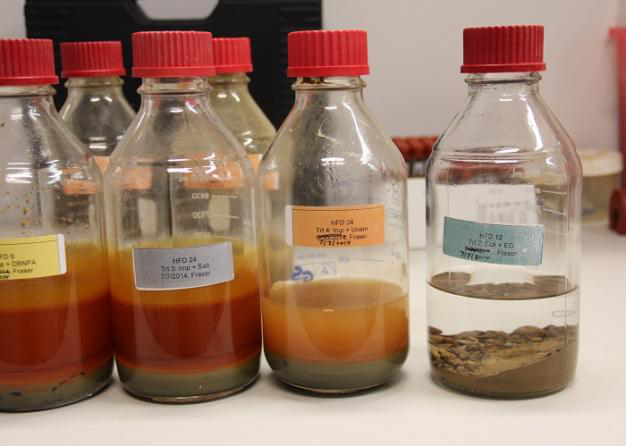
Sediment from a stream impacted by fracking wastewater develop orange residues after 90 days, while sediment from a clean stream did not. (Photo: Reid R. Frazier)
FRAZIER: In North Dakota, a million gallons spilled from a pipeline break and killed a swath of vegetation along its two-mile path.
Cozzarelli’s team is looking closely at one question - what happens when tiny organisms in the soil come in contact with frackwater. These bugs are like the Earth’s gut bacteria.
COZZARELLI: I guess you could call it the microbial flora, right?
FRAZIER: So they’re studying the everyday behaviors of these microorganisms.
COZZARELLI: And, so they have to do two things, right? They need food and they need to breathe.
FRAZIER: And some bacteria eat crude oil and chemicals found in oil and gas waste. So if some it spills on the ground, it’s like an all you can eat buffet for bacteria. That seems like good news right? The bugs can eat the contamination. But there is a catch. These bugs need to breathe, too. And they need to breathe more when they’re given a large new food source, like a frackwater spill. But underground, there is very little oxygen. Cozzarelli’s group says the bacteria they study evolved to thrive in this inhospitable environment.
COZZARELLI: And if you’re a human, you die, right? [LAUGHS] But if you’re a cool microorganism, you can breathe the nitrate or the iron or the sulfate because you’ve adapted to be able to do that.
FRAZIER: That’s right. These bacteria don’t need oxygen to breathe. They can even breathe in metals, like iron. Here’s where the problem starts though. The more food they get from a spill, the more iron they breathe. Iron minerals found in soil are a frequent host for another element - arsenic, a known human carcinogen. When a bacteria breathes that iron in, the arsenic is released, and becomes water-soluble.
COZZARELLI: And you can get more arsenic released into groundwater.
FRAZIER: That's what it appears happened at an oil spill site in Minnesota. Arsenic levels in the groundwater there are 20 times above the EPA limit for drinking water, though no one is actually drinking that water. So will bacteria help or hurt groundwater quality when frackwater gets on the ground? Cozzarelli says they’re just beginning to answer these questions.
COZZARELLI: I kind of feel like we’re trying to catch up. The industry’s just gone so quick.
FRAZIER: All this science could help in states where frackwater spills occur. In Pennsylvania, oil and gas companies have drilled 8,000 wells in the Marcellus shale. And state records show that spills or leaks of fracking waste are common. The mapping website FracTracker analyzed violations records from the state’s Department of Environmental Protection. It found 53 recorded spills of fracking wastewater in 2014; that's more than one a week. Many of these are small, only a few gallons, but some are not.
[DIESEL TRUCKS PULLING IN]
FRAZIER: In Washington County, in southwestern Pennsylvania, trucks removed contaminated soil from a hillside that used to house a wastewater pond. The John Day impoundment was ordered closed this year after the company that owns it, Range Resources, discovered high salt levels in the soil beneath its liner. The DEP found Range had leaks at several of its waste ponds in the area. In September, the company agreed to pay a record $4.15 million fine for these discharges.
FRAZIER: Range said in a statement it was disappointed by the violations, but said safety features at its new impoundments would go above and beyond DEP requirements. The DEP’s Scott Perry said the size of the fine reflects how seriously the state is taking the issue.
PERRY: Management of wastewater from oil and gas development is, in my opinion, the most critical environmental issue associated with the activity. Perry said the state is beefing up its rules on impoundments, which could include mandating two liners below each waste pit. That’s welcome news for residents like Janice Dumont. She lives next to one of the leaky impoundments, this one in Cecil Township, just south of Pittsburgh.
At her house, contractors are putting on new siding. The upgrades came courtesy of money Dumont and her husband received from Range Resources for a gas lease on their land. But word of a potential leak at the impoundment nearby has caused her to worry about groundwater.
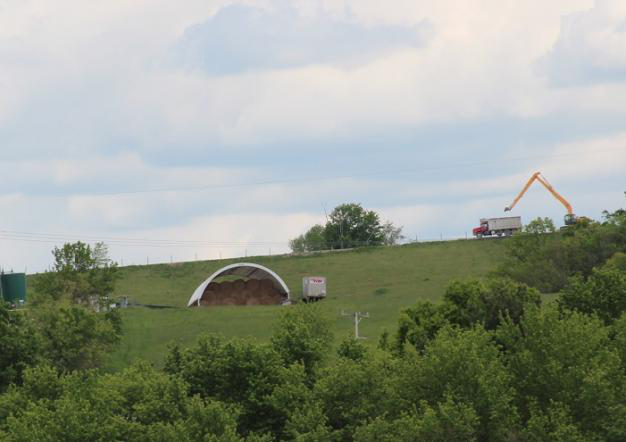
The John Day impoundment in Washington County, Pa. Range Resources excavated contaminated soil after it discovered a leak at the site. (Photo: Reid R. Frazier)
DUMONT: Range tested it, the DEP tested it, and there was no impact from the fracking pond.
FRAZIER: To see the leaky impoundment, all Dumont needs to take a ride on a cart.
[OUTDOORS WITH WIND BLOWING]
DUMONT: [LAUGHS] I got this for my 40th anniversary. It’s called a gator, a John Deere Gator.
[MOTOR STARTS]
FRAZIER: At the top of a steep hill, on the left, she points out the waste pit, which has been taken out of production. It’s cut into a hillside.
DUMONT: That was such beautiful farmland before...I guess it will be again...looks like a strip mine.
FRAZIER: A steep ravine separates her hill from the impoundment. She says a DEP inspector told her the ravine might act as barrier between pollution from the waste pond and her groundwater.
DUMONT: We were just fortunate, I think. We were lucky that we didn’t have any problems, because our well water is so good. I mean it’s delicious, it’s cold, and there’s no water bills.
FRAZIER: Range Resources will keep testing the groundwater, and will remove the impoundment by next year. Dumont says she won’t miss it. I'm Reid Frazier.
CURWOOD: Reid reports for the public radio program, the Allegheny Front.
Related links:
- Learn more about Fracking wastewater spills on the Allegheny Front’s page
- Our story on iron-eating bacteria
- U.S. Geological Survey
- In North Dakota, a million gallons of brine spilled from a wastewater pipeline break earlier this year and killed a swath of vegetation along its 2-mile path.
- Arsenic levels in an aquifer near Bemidji, Minnesota are 20 times above the EPA limit for drinking water, thanks to microorganisms’ chemical reactions.
- In Pennsylvania, oil and gas companies have drilled more than 8,500 wells in the Marcellus shale.
- FracTracker analyzed oil and gas violations records from the DEP and found 214 recorded spills in 2014; 53 were for oil and gas wastewater.
- In September, the Range Resources company agreed to pay a record $4.15 million fine for waste pond discharges.
- Range’s statement concerning the violations and its new impoundments
- The DEP is also attempting to fine The EQT Corporation $4.5 million for leaks at a 6-million gallon wastewater impoundment in northern Pennsylvania.
- EQT is challenging the fine, calling it “exorbitant.”
Fingerprinting Frackwater
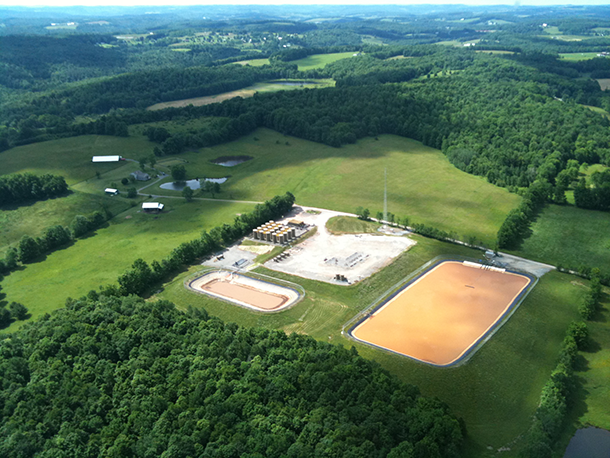
An aerial view of a wastewater pond located in the Marcellus Shale, Pennsylvania. (Photo: Prof. Robert Jackson)
CURWOOD: Now, as he [Allegheny Front’s Reid Frazier] was explaining, pinpointing the precise source of groundwater contamination can be tough. Many fracking chemicals are naturally occurring, or are used in other industries. But a study published a few months ago in the Journal of Environmental Science and Technology lays out a new forensic approach to help track down the exact source of fracking water pollution. One of the authors is Robert Jackson, who teaches at Stanford University. He spoke with Living on Earth’s Emmett Fitzgerald.
FITZGERALD: So tell me about a little bit about what you’ve done, about your study, and how that's addressing some of these problems.
JACKSON: Well, for a number years now, we've been interested in tracing the chemicals used in hydraulic fracturing fluids and also elements found naturally deep underground that might contaminate groundwater. That contamination could occur through a well that's made improperly or poorly, but it can also happen if wastewater leaks out into the environment. And oil and gas operations in United States generate a trillion gallons of wastewater every year. There's a lot of it.

Diagram of location of conventional and unconventional oil and gas reservoirs in ground formations. Fracking (drilling and pumping large quantities of chemical-laden water underground) helps access these reserves. Fracking fluids and water flow back to the surface carrying native chemicals and elements from the surrounding rock and clay formations. These chemicals and element ratios give each fracking wastewater source a specific analytical signature that can be used to identify it in the case of a spill. (Photo: Wyoming State Geological Survey)
FITZGERALD: So tell me a little bit about the work that you're doing, and how you're able to determine whether water has fracking fluids present in it.
JACKSON: Well, in this paper we focused on a handful of elements. Boron, lithium, in particular, but also salts, such as chloride, and even bromide. And we're focusing on these elements because some of them are added into hydraulic fracturing fluids - boron in particular - but all these things are found naturally deep underground. When the company pumps water deep underground to extract the oil and gas, some of that water flows back to the surface. When it does it carries those elements back with them, sometimes in very high concentrations. In the Marcellus [shale region], for instance, the water that comes back out of the well might be 10 times saltier than seawater, and so if that water that is produced out of the oil and gas well leaks onto the surface, then we can use the presence of these elements and their chemical signatures, the isotopes, to identify them.
FITZGERALD: So you call boron and lithium, in particular, tracers. What you mean by tracers?
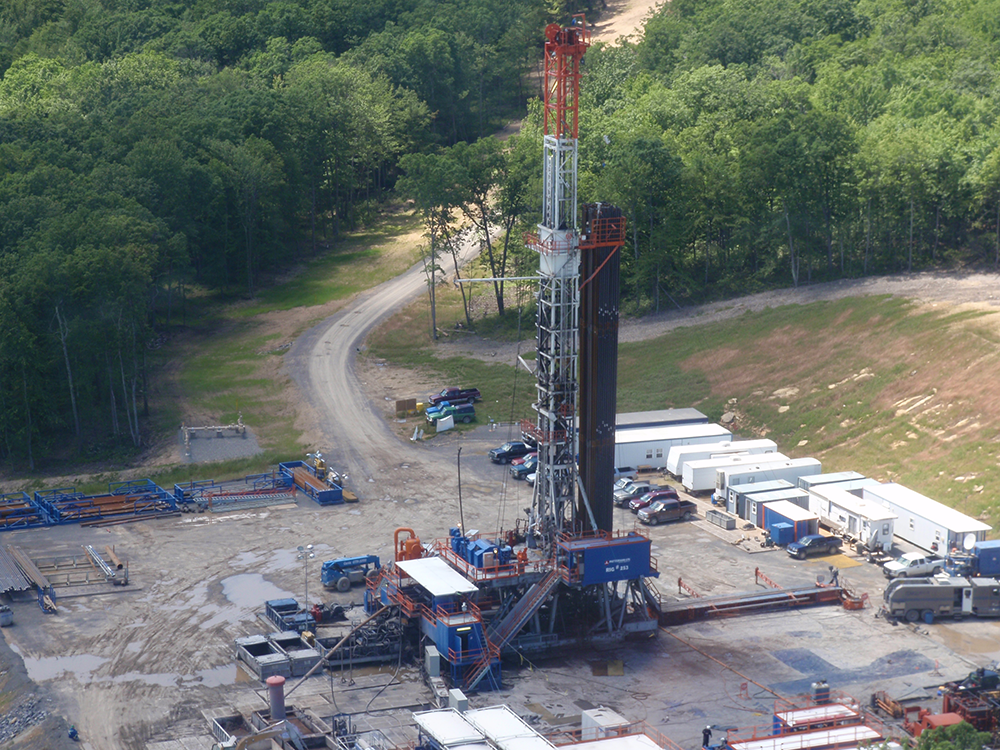
A drilling rig in Pennsylvania’s Marcellus Shale. There are over 1.1 million active oil and gas wells in the U.S., and over a trillion tons of fracking wastewater is generated in a year. (Photo: Prof. Robert Jackson)
JACKSON: A tracer is a compound that you can use to tell different sources apart. So when I talk about a tracer I'm thinking about something that might be found in different concentrations in different sources. It might be found in one source but not the other at all, or it might have a different chemical signature like its isotopic composition. So these compounds allow us, even at very low concentrations, to identify the source in the environment. So I'll give you an example. A few years ago, in the Monongahela River in Ohio and downstream there was this really big controversy about increases in bromine and other salts in the river water potentially impacting people's drinking water, and there was a lot of discussion about what the source of that was. Was it old coal mines, was it conventional oil and gas wells, or was it the newly hydraulic fracturing wells that were popping up all over the place in the watershed, or at least in the wastewater that was being brought to the watershed?
So this kind of approach allows us to disentangle, to distinguish those kinds of situations. We can separate different waste streams and tag them back to their source.

Truckers ship fracking wastewater around the country for clean-up and processing. (Photo: Prof. Robert Jackson)
FITZGERALD: So basically you're looking at the chemical, the presence, the concentration, the isotopic situation with these different compounds and indirectly you’re able to say well this possibly came through fracking chemicals rather than the way it would occur naturally.
JACKSON: That's right. These tracers and many others that we've developed and many other groups around the world have developed allow us to identify the source of contamination in the environment really well.
FITZGERALD: Why would we want to use this approach?

An aerial view of a wastewater treatment plant in Pennsylvania’s Marcellus Shale. (Photo: Prof. Robert Jackson)
JACKSON: We want to be able to keep track of wastewater in the environment. We might want to see if a wastewater treatment facility is working properly. We might want to identify the source of a potential spill, if somebody thinks a spill has happened in their neighborhood or in their stream or river, has it actually happened and if it's happened what caused it? This allows us to go in and identify the sources of contamination in the environment and that's really important and very useful.
FITZGERALD: Professor Jackson, you called this a "forensic approach"...can you explain what you mean?
JACKSON: Well, at a crime scene, investigators will go in and apply a forensic approach. They might gather DNA. They might gather blood types. They might gather hair, and they assemble a set of evidence to assess a probable cause, a probable weapon, even sometimes a probable person. So in science we can talk about forensics in the same way, we can gather and apply a suite of chemical analyses and then apply them to a particular situation and try to figure out what caused the problem.
FITZGERALD: You're fingerprinting fracking wastewater?
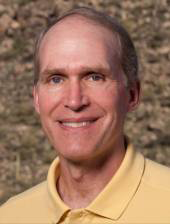
Robert Jackson is a Professor of Environmental Earth System Science at Stanford University and co-author on the study “New Tracers Identify Hydraulic Fracturing Fluids and Accidental Releases from Oil and Gas Operations” published in the Journal of Environmental Science & Technology. (Photo: Stanford University)
JACKSON: We are fingerprinting fracking wastewater. It's not the same scale of resolution as a DNA identification. It's not a one in 100 million or one and 1 billion chance. The tools are not that accurate, but they're pretty accurate.
FITZGERALD: In the end, what do you hope comes out of this research?
JACKSON: All of the research that I do in this area has a single purpose in mind. We want to improve things to make things better so we can provide some tools that companies and regulators can use to keep spills from happening, to track wastewater in the environment better and ultimately to make the entire process safer, then I think that's a good reason for doing the work. There's also a basic science component to this we're learning about what's found naturally deep underground so when I get a basic science project and a project with strong relevance today, I'm happy about that.
CURWOOD: Robert Jackson is a co-developer of the frackwater forensic fingerprint technique.
He teaches at Stanford University, and spoke with Living on Earth’s Emmett Fitzgerald.
Related links:
- Read the original study
- Duke’s press release on “New Tracers Can Identify Fracking Fluids in the Environment”
- Study co-author and Professor Robert Jackson’s Stanford University webpage
- Locate over 1.1 million active oil and gas wells, spills and wastewater injection on FracTracker
- Difficulty making frackwater clean-up profitable, our piece.
- ThinkProgress’ piece on tracking fracking waste
- Inappropriate disposal of solid, radioactive frackwaste contaminates water, our story.
[MUSIC: Jimmy Smith, Back at the Chicken Shack, Back at the Chicken Shack, The Incredible Jimmy Smith, Blue Note, 2007]
Beyond the Headlines
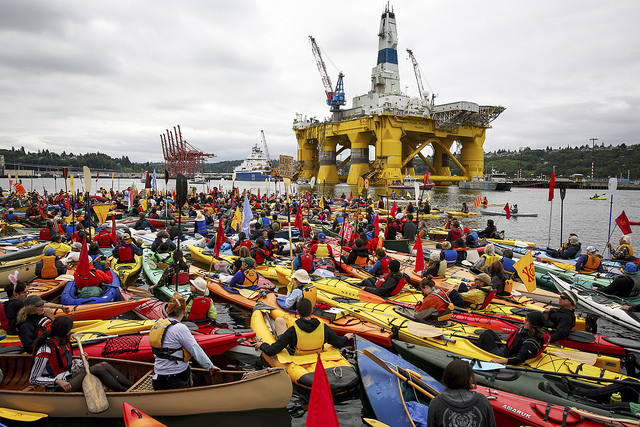
In mid May 2015, hundreds of “Kayaktivists” gathered off the coast of Seattle chanting “Shell no” in protest of the company’s latest attempt to drill for oil in Alaskan waters. Shell’s plan to dock its rigs in Seattle’s harbor was opposed by Mayor Ed Murray and the City Council in addition to environmental advocates. (Photo: Backbone Campaign, Flickr CC BY 2.0)
CURWOOD: Well, we’ll check up on the world beyond the headlines now. Peter Dykstra keeps a close eye on all the news as part of the team at DailyClimate dot org and Environmental Health News, ehn dot org – and he joins us on the line now from Conyers Georgia – hi Peter!
DYKSTRA: Well, hi Steve, you know, there’s a lot going on in the Arctic in oil and gas exploration, so let me rattle off a few developments.
CURWOOD: Okay…
DYKSTRA: Of course there’s been a lot of attention to Shell’s second try at drilling in the Beaufort Sea off the Northwest Coast of Alaska. Shell’s rig, Polar Pioneer, docked in Seattle on its way up north in May and was hounded by waterborne protesters – “Kayaktivists,” about two dozen of whom were arrested, but the Polar Pioneer is now well on its way to the Arctic with plans to drill in 8,000 feet of water.
[Correction: "We were incorrect to state that Shell plans to drill in the Beaufort sea in 8,000 feet of water. Shell plans to drill a well 8,000 feet deep in the Chukchi Sea, in water only that's a few hundred feet deep. We apologize for the error.]
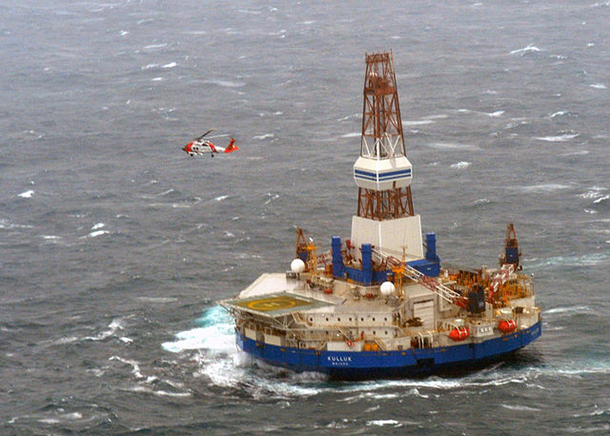
A report written for Fisheries and Oceans Canada suggests that Canada does not have enough data about species in Arctic waters, like Arctic cod, to predict how they would be impacted by an oil spill, if it were to happen. It also warns that drilling operations at depths of over 1,000 feet can create dangerous oil plumes that linger below the water for days. (Photo: Petty Officer 3rd Class Jonathan Klingenberg, US Coast Guard, Public Domain/Wikimedia Commons)
CURWOOD: 8,000 feet, so that much deeper than the ill-fated Deepwater Horizon well in the Gulf of Mexico.
DYKSTRA: Well over a mile deep, in often-brutal Arctic conditions, in the wake of a comical first attempt in 2012 when Shell’s first rig ran aground on the way up North.
CURWOOD: So what could possibly go wrong?
DYKSTRA: I’ll tell ya. There are drilling plans in the Canadian Arctic as well – and the Globe and Mail newspaper got its hands on a government document that concludes Canada is in no way ready to respond to an oil spill in its section of the Arctic. Of course, those same concerns have been raised for drilling off Alaska. But Wait! There’s more!
CURWOOD: We’re listening.
DYKSTRA: Oil prices are really low right now, with no immediate prospects of a huge increase. Recently, BP, ExxonMobil and Imperial Oil announced they’re suspending their drilling plans for the Beaufort Sea for at least five years, so responding to a Canadian spill may be a moot point for now. Chevron had already made a similar announcement.
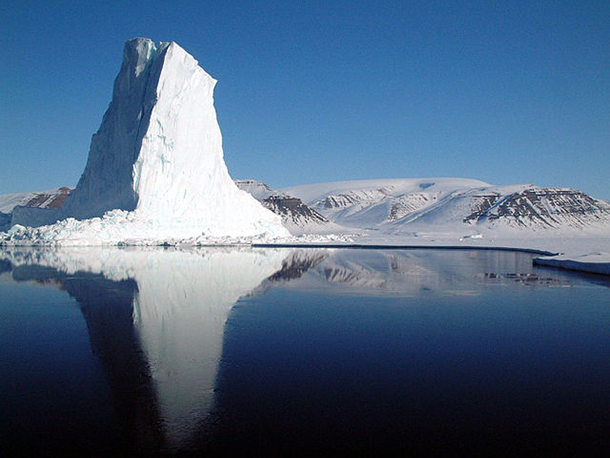
To the elation of Baffin Island residents, a Norwegian-based energy company consortium has called off its plans to perform seismic testing in the eastern Arctic’s Baffin Bay—at least for this summer. Air cannons produce loud booms, which are used to locate oil deposits on the ocean floor. This sonic noise can harm whales, walruses and seals, which the Inuit hunt for food. (Photo: Tech. Sgt. Dan Rea, US Air Force, Public Domain/Wikimedia Commons)
CURWOOD: So can we say things are, well, frozen in the Canadian Arctic?
DYKSTRA: Well, yes and no. Here’s another one. There’s a big split among Arctic natives, some want the development that oil & gas can bring, some want to take no chances whatsoever with jeopardizing Arctic culture – but First Nations communities on Baffin Island in the eastern Canadian Arctic were dead-set against seismic testing – using those booming air cannons that test the ocean floor for oil deposits.
CURWOOD: Which are a potential risk to whales….
DYKSTRA: …And seals, and walrus – the centerpieces of Arctic diet and custom. The oil industry has agreed to postpone the seismic tests for this year, but we’ll see what happens in the future. And one more Arctic note: Russia is also eager to drill in its part of the Arctic, but they’re held back by the worldwide sanctions against the Putin government over its incursion into the Ukraine. We’ll try and keep you posted to what’s happening in the Canadian, the Russian, and the American Arctic.
CURWOOD: Okay. Thanks, and part of the backdrop is the irony that the drilling becomes more possible as the Arctic thaws. All right Peter, take us back into the annals of environmental history.
DYKSTRA: Steve, this past week was the bicentennial of gas
CURWOOD: Of gas?
DYKSTRA: Natural gas, to be precise. Captain James Wilson was an upstanding citizen of Charleston, now the capital of West Virginia. This was back in 1815; it was a frontier town. The good captain was drilling for salt brine when he accidentally hit a gas deposit and you know what happened next….
CURWOOD: Let me see, he became an energy millionaire?
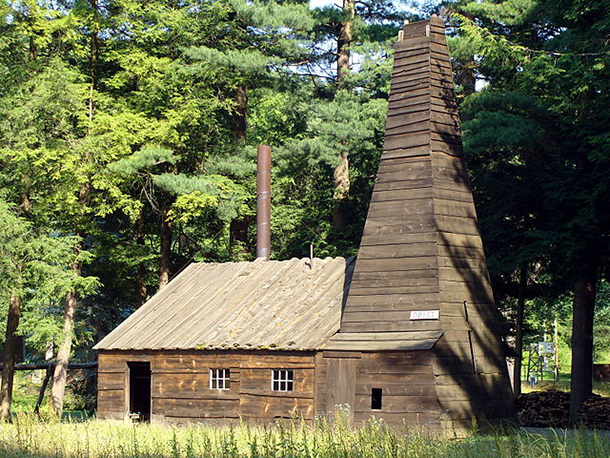
In 1815, Captain James Wilson stumbled upon a natural gas deposit while drilling for salt brine in West Virginia, but opted to stick with the salt business instead of capitalizing on the discovery. Edwin Drake drilled the world’s first oil well 44 years later in Titusville, Pennsylvania. (Photo: Niagara, Wikimedia CC BY-SA 3.0)
DYKSTRA: No, the well blew up, and according to a historical account, the Captain “did not dare to tempt Providence” and drill any further because he was a salt brine man, he wasn’t going into this explosive stuff. Anyway, the salt brine went to Charleston’s growing salt works business, and a few years later, coal took hold in West Virginia, they used the coal to turn the salt brine into chlorine chemicals which also became a business fixture there. Edwin Drake discovered petroleum a few hundred miles north in 1859, others eventually came back to large-scale natural gas wells, and fast-forward to today when we’re planning to drill for oil in the warming Arctic, we’ve removed entire mountains for coal in Appalachia, and we’re fracking for oil and gas all over the map.
CURWOOD: And while that captain didn’t dare tempt Providence—in the Arctic, and elsewhere--I guess we do. Thanks Peter! Peter Dykstra’s with Environmental Health News, that’s EHN.org and thedailyclimate.org. We’ll talk to you again soon.
DYKSTRA: Alright, Steve, thanks a lot. Talk to you soon.
CURWOOD: And there’s more on these stories at our website, LOE.org
Related links:
- Kayaktivists protest drilling in Arctic
- Canada isn’t prepared for an oil spill
- Baffin Island seismic testing cancelled for now
- “Russian Oil Giant Rosneft Is Delaying Arctic Drilling Plans Amid Western Sanctions Against Moscow”
- The Drake Oil Well
[MUSIC: Jimmy Smith, Back at the Chicken Shack, Back at the Chicken Shack, The Incredible Jimmy Smith, Blue Note, 2007]
CURWOOD: Coming up...the joys of kelp...honestly! That's just ahead on Living on Earth. Stay tuned.
ANNOUNCER: Funding for Living on Earth comes from United Technologies, a provider to the aerospace and building systems industries worldwide. UTC Building & Industrial Systems provide building technologies and supplies container refrigeration systems that transport and preserve food and medicine with brands such as Otis, Carrier, Chubb, Edwards and Kidde. This is PRI, Public Radio International.
[CUTWAY MUSIC: Dr. Lonnie Smith, Tropicalia, Boogaloo to Beck, Scufflin Records, 2013]
Restoring Giant Kelp Forests
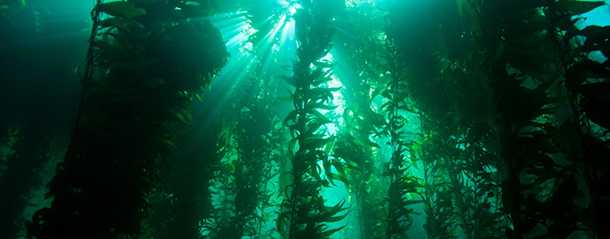
Kelp forests can grow up to 18 inches per day and prefer cold, nutrient-rich waters. (Photo: NOAA; CC government work)
CURWOOD: It's Living on Earth. I'm Steve Curwood. In late August of 2014, huge mounds of the largest type of seaweed in our oceans, kelp, started piling up on Laguna Beach in Southern California. Tourists and would be sun-worshippers were not happy as the smelly thick brown ribbons took over the sand. Scientists estimated that hurricanes had ripped as much as 95 percent of the offshore kelp forest from the ocean floor nearby. But marine biologist Nancy Caruso says all [of] that fly-ridden gunk on the beach is actually a sign of a healthy underwater ecosystem. Caruso is founder of the nonprofit Get Inspired!, which organizes volunteers and students to restore the kelp forests, and she joins us from Garden Grove, California. Welcome to Living on Earth.
CARUSO: Thank you very much; I appreciate that.
CURWOOD: So explain to me exactly why all that kelp washing ashore is a sign, or could be a sign, of a thriving ecosystem?
CARUSO: Well, 12 years ago, myself and a group of students and volunteers all started a project to restore the kelp forests off of Orange County's coast. We've been kind of waiting as our restoration efforts appear to be successful. The real test comes when something like a hurricane or big swells coming out of the south show up and rip out all of our kelp, which is a natural occurrence, kind of like forest fires in the forest, where the forest is destroyed so to speak, but new life can start.

Kelp forests can be seen along much of the west coast of North America. Kelp are large brown algae that live in cool, relatively shallow waters close to the shore. They grow in dense groupings much like a forest on land. (Photo: NOAA’s National Ocean Service; CC BY 2.0)
So big holes have been created in the canopy of the forest and new life can grow from the bottom up, and so if we see this happen, which we're seeing right now, the kelp returns immediately after this event, then we know that our restoration efforts are successful, and after 30 years of our local ecosystem not having healthy kelp forests, we can rest assured that it's now restored and everything is back to normal again.
CURWOOD: For a moment let's talk about kelp itself. What does it look like and what is it taste like?
CARUSO: Well it looks like trees underwater, if you can imagine. Imagine being in a cathedral with stained glass windows and there's light dancing through the stained glass windows onto the floor, and that's what it looks like underwater in a kelp forest—these beautiful amber blades that the water...the sunlight, rather, dances through on the bottom of the ocean and creates beautiful light patterns. And as far as how it tastes, well, that's really up to the animal that's eating it, but for humans we actually eat it as well. Kelp contains a compound called alginate and it's used as an emulsifying and thickening agent so it binds things together and it makes things creamy and smooth. So if you ever had a diet salad dressing, for instance, if you take the fat out of it then it's not really creamy anymore, but you can add alginate back into it and that will give it the creamy texture. So we've eaten a lot in alginate in our lives, we're just not familiar with the fact that we're all intimately tied to giant kelp.
CURWOOD: How big are these giant kelp?
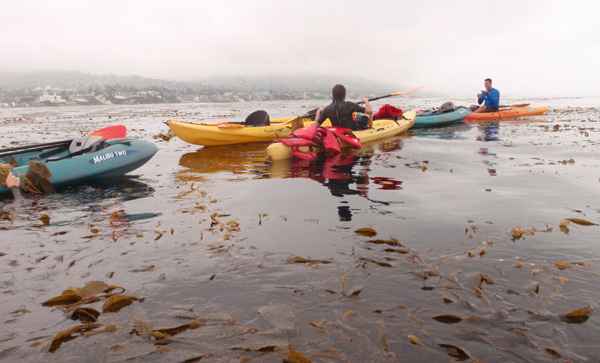
Get Inspired! Tour: Nancy Caruso and Pacifica High School students paddle out to evaluate the restored kelp forest. (Photo: courtesy of Nancy Caruso)
CARUSO: That's a good question. They're not called giant for nothing. So they can grow up to about 110 feet tall and they often, however, grow in water that's less than 30 feet deep. So the kelp forest grows up to the surface, then we have another 80 feet of kelp that just spreads out along the surface and creates what's called a canopy. And the canopy also provides cover for those fish that are swimming up and down our coast following the plankton, following the currents, and they can hide underneath that canopy from pelicans and other diving birds that are just waiting to eat them.
CURWOOD: So, Nancy, talk to me about how you actually restore kelp. I'm envisioning you strapping on a tank and mask and flippers and everything and going down there to plant little kelp seeds.
CARUSO: It was actually quite an effort because I had the help of 5,000 students from ages 11 to 18 as well as 250 skilled volunteer divers, and we planted this kelp in 15 different areas in Orange County. There's a spot down in Dana Point. It's the only kelp forest that was left in Orange County so we would collect the reproductive blades from those kelp plants, and I would take them into the classrooms for the students to clean them and we would actually stress them out overnight. We would leave them out of water in the refrigerator, kind covered with paper towels, and then the next morning we would put them back in the ice-cold seawater and the kelp blade would release millions of spores. They're microscopic. They're 400 times smaller than you can see, and we would get these spores to land on small little bathroom tiles, and then we would raise them in the classrooms in little nurseries that we built out of Home Depot parts and fittings, and the kids would raise them for about four months, just to the point where you can see them with your naked eye and then we would take these tiles out in the ocean.
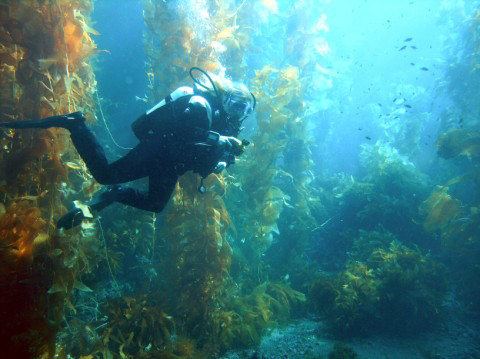
A diver swims among giant kelp, which can grow as tall as 110 ft. (Photo: Ed Bierman, Wikimedia Commons CC BY 2.0)
After the kids learned all the ecology and biology and how the kelp disappeared, how to protect it, they became warriors for the kelp and then the volunteers would take it out into the ocean and using a rubber band really simply attach the tile to the reef. There would be thousands of kelp spores growing on each tile, and they would all outcompete each other and its root system, called the holdfast, would just grow off of the tile and attach itself to the reef, and the tile was nonleaded and unglazed so it could actually biodegrade - a rubber band is biodegradable - and there is kelp out there still that has started off from our tiles, so it's really gratifying to see that.
CURWOOD: Ah, you are the grandmother of how much kelp?
CARUSO: A whole lot!
CURWOOD: So what did the kelp forest look like before you started this restoration effort? Why did they disappear?
CARUSO: Well, it's actually a long process to collapse an ecosystem. We used to have furry little mammals living down here in Southern California called the southern sea otter, and they've been gone since the 1840s when the last otter was killed in southern California. Without the sea otter, things immediately started to go out of balance because the sea otter is kind of the top scavenger, I guess, in the oceans here and it keeps all of the animals that eat the kelp in place. So the otter disappeared and therefore the sea urchin populations got out of whack and we ended up with a lot of sea urchins on the reef and they basically mowed down the kelp forest.
So it started with the demise of the otter and then paving over the surfaces of southern California to where we don't have...or we have lots of runoff creating cloudier turbid waters off of our coast, and kelp likes sunlight. It is actually an algae, so it produces food for itself through photosynthesis, and it can't grow in deeper waters anymore. And the third and last straw for the demise of our kelp forests was actually the El Niño event of 1983, and that kind of like this year ripped out all of the kelp that was left in the area, however, there was so many other pressures on it, it never actually made it back.
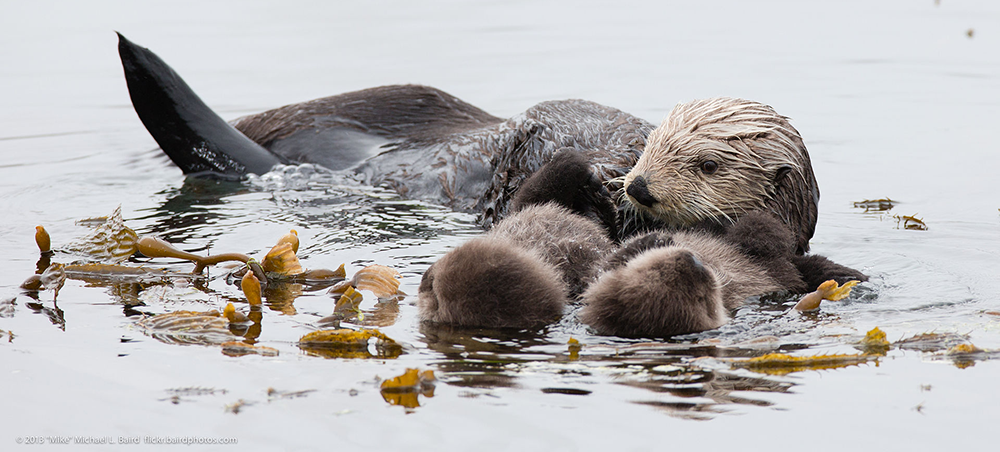
Sea otters often tangle themselves up in kelp while they’re sleeping. Sea otters are crucial to a healthy kelp forest; they eat sea urchins and other invertebrates that feed on giant kelp. (Photo: Mike Baird; Wikimedia Commons CC BY 2.0)
CURWOOD: So talk to me about the responsibility that we as people have to restore kelp forests since we contributed to their decline.
CARUSO: Well, first and foremost, the number one thing that we can do is to stop runoff from going into the ocean. We don't get a lot of rain here, so every time it rains or whenever you're overwatering your lawn or washing your car, that water goes down our sidewalks, down our streets, washes over everything that's on the streets and sidewalks into the sewer system and directly into the ocean in most cases. And so trying to eliminate that runoff and the things that are on the streets and on the sidewalks that go with the water into the ocean is critically important and something that everybody can do on a daily basis.
CURWOOD: So, Nancy, I've got to tell you, I spent time near Capetown, South Africa, where there's a huge kelp forest offshore, and that means that on the beach there are piles and piles of this big huge kelp. And it's kind of smelly. It's got a lot of flies; people feel annoyed that they can't use that part of the beach. How do you cope with that? People come to southern California they want to, you know, go down to the beach and here you've got this stuff.
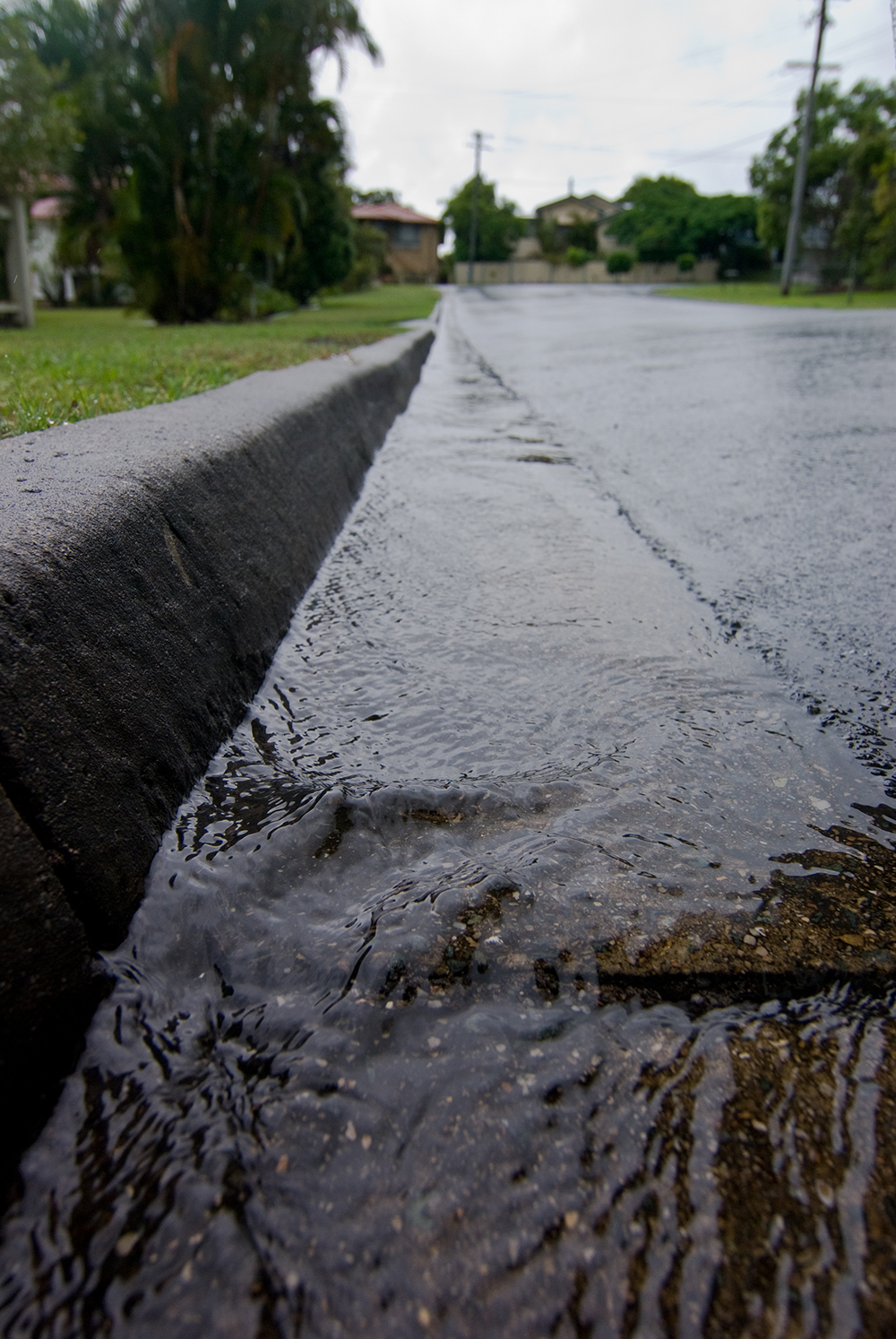
Among a few factors contributing to the decline in kelp is runoff from California’s agricultural sector. (Photo: Craig Jewell, CC BY-NC-SA 2.0)
CARUSO: Well, kelp actually has a purpose when it washes up on the beach. It doesn't just end its life when it gets pulled off of the reef. Inside that massive wrangled tangled kelp, there're literally hundreds of animals living. So you'll see kids often going through the plant looking for starfish, crabs, lobsters and sea urchins and usually there's a chance actually for it to get washed back out again. And this is just like the process that I explained where we stressed the kelp out in the classrooms to get it to grow. We would take it out of the ocean and stress it out, keeping it moist and cool, which it does on the beaches, it's all wrapped up and stays moist and it shades itself, and then when the tide comes up again it can get washed back out into the cold water of the ocean and it'll reproduce. But also all those animals that get washed up on the beach inside the wrangled tangled kelp become a food source for shorebirds that live along our coast, and also there's a really special fish here in southern California called the Grunion, and it only spawns on our beaches, not in the water but actually in the sand, and it only does it certain times during the year and it's a big event, everybody goes out to watch it, it's at night you know during certain phases of the moon, and the kelp can actually keep the sand moist on top of the eggs of these Grunion, so there's a whole ecosystem that occurs when the kelp gets washed up.
CURWOOD: What about the tourists? How does all the kelp affect the tourism?
CARUSO: Well, when you go to a forest and there's leaves all over the ground, most people don't complain about that because they know that that's a natural process of leaves falling on the ground. So it's really about educating people what the kelp forest ecosystem is, and why it's important, and the whole entire cycle, not just out in the ocean and underwater, that slimy stuff that grabs my ankles when I swim over it, but it's also part of the beach, coastal ecosystem.
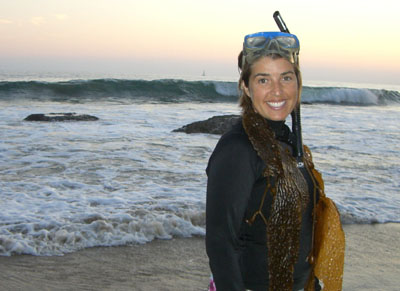
Nancy Caruso is a marine biologist and the founder of Get Inspired!, a program that performs kelp restoration in California. (Photo: courtesy of Nancy Caruso)
CURWOOD: And it has these tiny little crabs and periwinkles and stuff running around inside it.
CARUSO: Umm hmm. Exactly.
CURWOOD: So, you're so excited about kelp. When did you fall in love with kelp?
CARUSO: Well, I wanted to be a marine biologist since I was 10 years old in Virginia and ended up going to school in Florida and just by happenstance I made it out here to California and worked for a local public aquarium and that's where I really, I mean as a kid I watched Jacques Cousteau diving in the kelp forest in the Catalina Island in southern California and I often thought wow that's so cool like I wish I could go there, and when I finally ended up here I was just taken in by their majesty and their beauty.
CURWOOD: And shocked then that off of Orange County they were gone.
CARUSO: Yeah. The beautiful thing was that I was looking to do work within the community. I wanted to work with people and get people excited about doing conservation work, and then this opportunity to start up the kelp program became available to me and it was exactly what I wanted to do. I've kind of been able to become a messenger for the kelp and to give it a voice so to speak, so I'll keep an eye on it for as long as I can.
CURWOOD: Nancy Caruso is the Founder of Get Inspired! It's a nonprofit that gets Southern California residents involved in kelp forest restoration. Nancy, thanks so much for taking the time with us today.
CARUSO: Thank you so very much.
Related links:
- The Get Inspired! Website and photo gallery
- Live Kelp Forest Cam at the Monterey Bay Aquarium
- What is a kelp forest?
Fighting Invasive Ribbon Grass
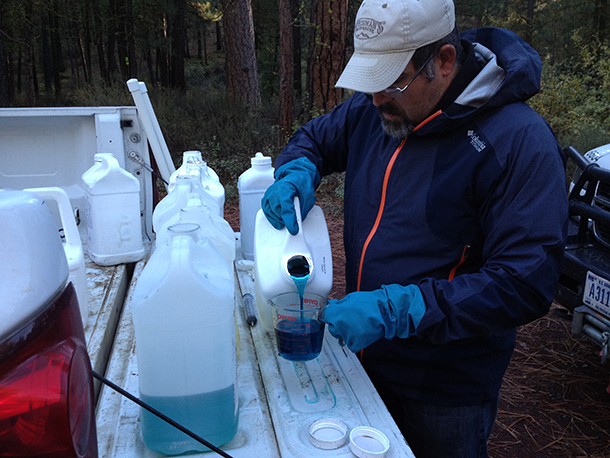
Mike Crumrine adds dye to an herbicide mixture so that he can see where he applies it. Crumrine is applying herbicides to an invasive plant, ribbon grass that is choking Oregon's Metolius River. (Photo: Courtesy of Maret Pajutee)
CURWOOD: Now, from restoring a plant associated with water...to ripping one out! You’ve probably seen ribbon grass. It’s a pretty, leafy plant, and Better Homes and Gardens calls the variegated kind “a perfect plant for adding a dose of color anywhere you don't want to maintain; it's a fast-spreading variety perfect for covering slopes.” But “perfect for covering slopes” makes it something of an invasive nuisance in the Northwest, where it’s choking one of Oregon’s most pristine waterways. Courtney Flatt from the public media collaborative EarthFix has the story.
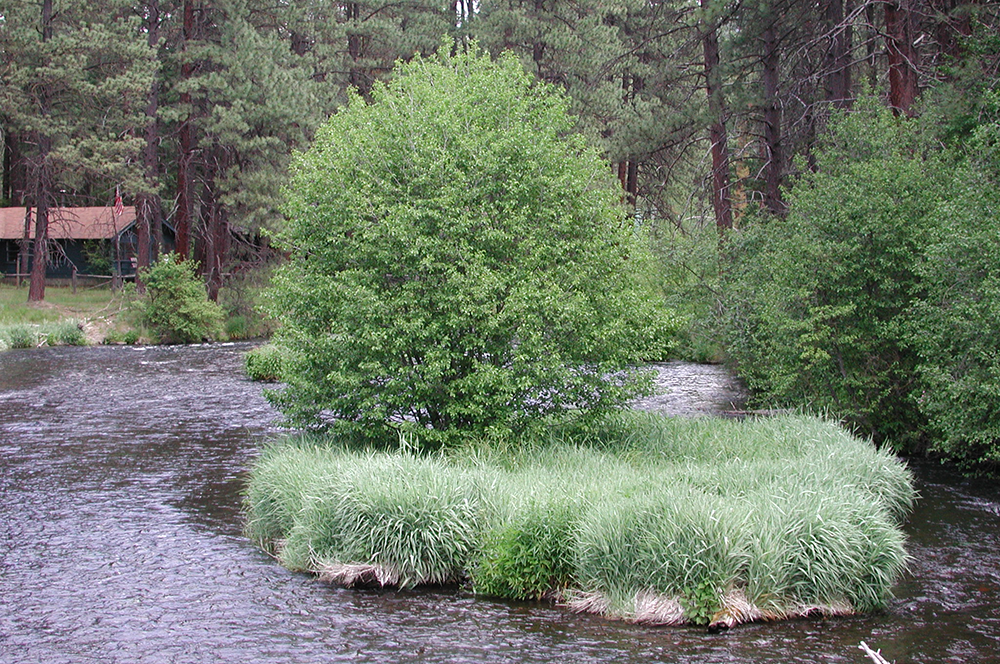
An island covered in ribbon grass. (Photo: Courtesy of Maret Pajutee)
FLATT: Looking at the banks of the Metolius River in central Oregon, nothing really seems wrong. But train your eye a little, and you start noticing large patches, even entire islands, covered in thin, green grass. Merit Pajutee’s a forest service ecologist.
PAJUTEE: Aldo Leopold said that living with an ecological consciousness is like living in a world of wounds.
FLATT: The wound on the Metolius River is ribbon grass. Its bunches of leaves have squeezed out native sedges and wildflowers. As the wildflowers disappeared, the number of pollinating insects dropped. Pajutee says rumor has it ribbon grass came to Oregon in the 50s, when someone planted the pretty grass in a flowerbed. Then, like most invasive plants, it kept growing.

The same island after treatment. Friends of the Metolius covered the island with a black tarp, hoping that less sunlight would kill the ribbon grass. They left the tarp on for three years. It killed the ribbon grass, but also killed other plants on the island. (Photo: Courtesy of Maret Pajutee)
PAJUTEE: And I think the reason it has done so well here is the character of the Metolius, and its spring-fed nature. It really found the perfect home, where it can spread.
FLATT: Ribbon grass is found throughout the Northwest. It’s relatively contained, but here on the Metolius it’s growing like crazy.
The Metolius is a wild and scenic river. It’s home to Oregon’s healthiest bull trout population and recovering salmon sockeye runs. One of the big concerns is that ribbon grass doesn’t provide a lot of cover for fish to hide in the winter. That’s why this year the Oregon legislature listed ribbon grass as an official noxious weed.
One organization trying to get rid of the ribbon grass is the Friends of the Metolius. For years the conservation group tried several tactics. They tried throwing black tarps over the grass. That didn’t work as well. Then they hand picked it. Pete Schay is with the Friends of the Metolius. He says handpicking the weeds was backbreaking labor.
SCHAY: It’s very heavy. It’s mostly water. It’s 99 percent water that you’re pulling - dragging around.
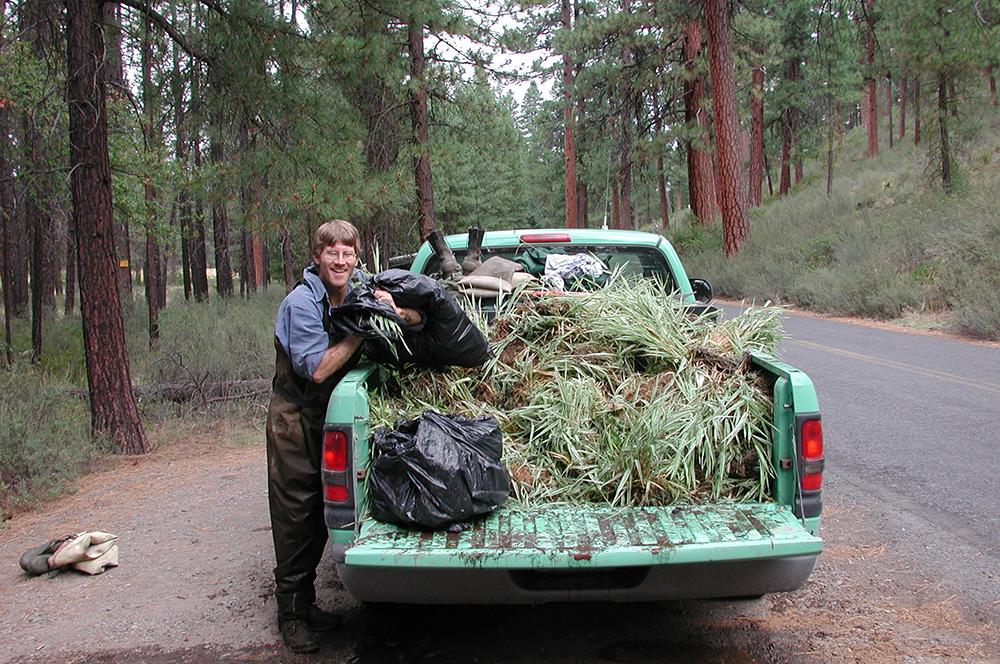
Crews filled a truck bed with ribbon grass they hand picked. (Photo: Courtesy of Maret Pajutee)
FLATT: Crews filled an entire pickup truck with weeds. They took the ribbon grass to a gravel pit and covered it with a tarp to kill it. A couple years later, the ribbon grass started growing back.
Now, they’re trying herbicides. Mike Crumrine is with the Oregon Department of Agriculture. He wades through the frigid waters.
CRUMRINE: Wiping the herbicide on with, in essence, a sponge. Rubbing the plant, every bit of the plant that you can get to that’s above water level, is the target goal.
FLATT: There’s a small window every fall when Crumrine can apply the herbicide.
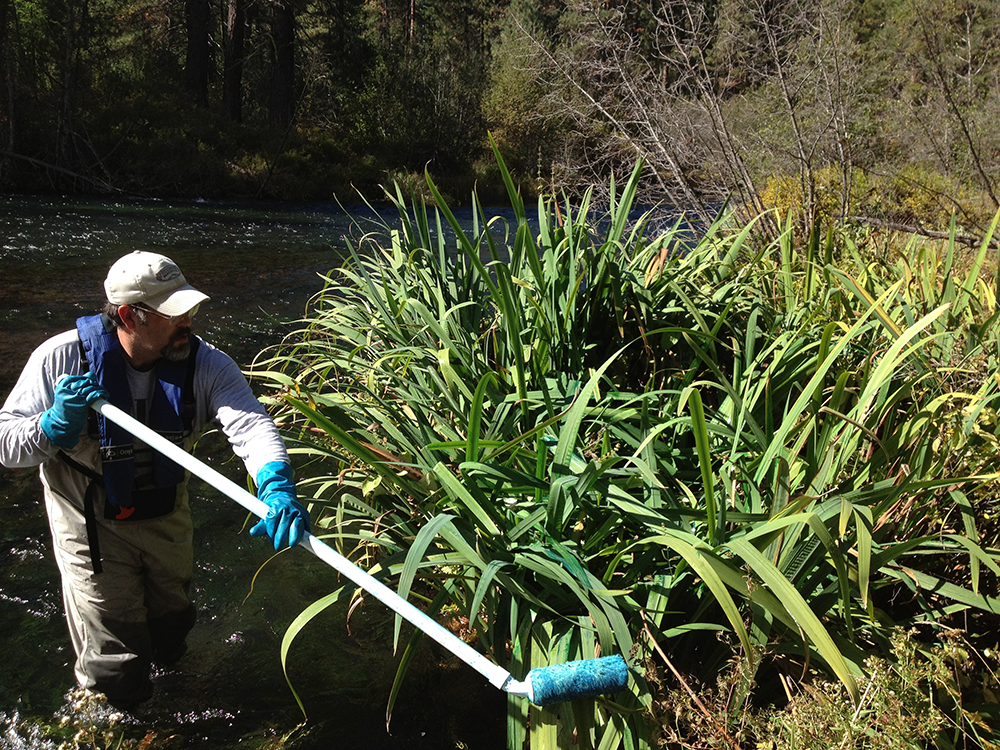
Mike Crumrine applies herbicide to yellow iris, another invasive plant on the Metolius River. (Photo: Courtesy of Maret Pajutee)
REPORTER: So do you think you’ll ever be able to knock it all out?
CRUMRINE: Eventually, yes, I have some great hope. Looking at what we’re looking at right here, right now, I would estimate we’re looking at a 90 percent reduction.
FLATT: Water quality tests have shown the herbicides haven’t hurt fish or other species in the river. And the herbicides are working. There are finally a few places where native plants have started to come back.
I’m Courtney Flatt in Sisters, Oregon.
CURWOOD: Courtney reports for the public media collaborative Earthfix.
Related link:
Read more about ribbon grass and management of the species on EarthFix.
[MUSIC: Hall and Oats “I Can't Go for That (No Can Do)” from Private Eyes (RCA 1981)]
CURWOOD: Next time on Living on Earth - on the trail of poachers targeting massive sturgeon
JONES: They're the coolest looking fish that swims in the river. They look prehistoric. They don't have any bones. They're cartilaginous similar to a shark, and the older they get the more eggs they can produce.
CURWOOD: But those eggs can make them worth hundreds of thousands of dollars. That’s next time on Living on Earth
[MUSIC: Hall and Oats “I Can't Go for That (No Can Do)” from Private Eyes (RCA 1981)]
CURWOOD: Living on Earth is produced by the World Media Foundation. Naomi Arenberg, Bobby Bascomb, Emmett Fitzgerald, Helen Palmer, Adelaide Chen, Jenni Doering, Lauren Hinkel, Shannon Kelleher, and Jennifer Marquis are all part of our team. Our show was engineered by Tom Tiger, with help from Jake Rego, Noel Flatt and John Jessoe. Alison Lirish Dean composed our themes. You can find us anytime at LOE.org - and like us on our Facebook page - it’s PRI’s Living on Earth. And we tweet from @LivingOnEarth. I'm Steve Curwood. Thanks for listening.
ANNOUNCER1: Funding for Living On Earth comes from the Grantham Foundation for the protection of the environment, supporting strategic communications and collaboration in solving the world’s most pressing environmental problems. Support also comes from Trinity University Press, publisher of Moral Ground; Ethical Action For A Planet In Peril, 80 visionaries who agree with Pope Francis, climate change is a moral issue for each of us. T-U-Press dot org, and Gilman Ordway for coverage of conservation and environmental change.
ANNOUNCER2: PRI. Public Radio International.
Living on Earth wants to hear from you!
Living on Earth
62 Calef Highway, Suite 212
Lee, NH 03861
Telephone: 617-287-4121
E-mail: comments@loe.org
Newsletter [Click here]
Donate to Living on Earth!
Living on Earth is an independent media program and relies entirely on contributions from listeners and institutions supporting public service. Please donate now to preserve an independent environmental voice.
NewsletterLiving on Earth offers a weekly delivery of the show's rundown to your mailbox. Sign up for our newsletter today!
 Sailors For The Sea: Be the change you want to sea.
Sailors For The Sea: Be the change you want to sea.
 The Grantham Foundation for the Protection of the Environment: Committed to protecting and improving the health of the global environment.
The Grantham Foundation for the Protection of the Environment: Committed to protecting and improving the health of the global environment.
 Contribute to Living on Earth and receive, as our gift to you, an archival print of one of Mark Seth Lender's extraordinary wildlife photographs. Follow the link to see Mark's current collection of photographs.
Contribute to Living on Earth and receive, as our gift to you, an archival print of one of Mark Seth Lender's extraordinary wildlife photographs. Follow the link to see Mark's current collection of photographs.
 Buy a signed copy of Mark Seth Lender's book Smeagull the Seagull & support Living on Earth
Buy a signed copy of Mark Seth Lender's book Smeagull the Seagull & support Living on Earth

